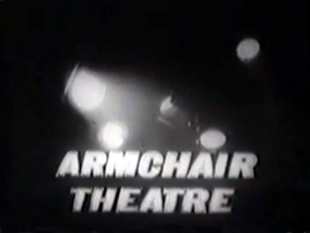
Armchair Theatre is a British television drama anthology series of single plays that ran on the ITV network from 1956 to 1974. It was originally produced by ABC Weekend TV. Its successor Thames Television took over from mid-1968.
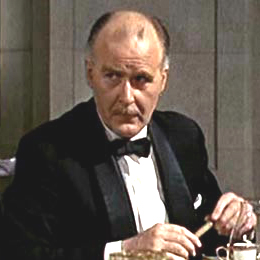
Richard Evelyn Vernon was a British actor. He appeared in many feature films and television programmes, often in aristocratic or supercilious roles. Prematurely balding and greying, Vernon settled into playing archetypal middle-aged lords and military types while still in his 30s. He is perhaps best known for originating the role of Slartibartfast in The Hitchhiker's Guide to the Galaxy. Other notable roles included the lead role of Edwin Oldenshaw in The Man in Room 17 (1965–67), Sir James Greenley alias "C" in The Sandbaggers (1978–80), and Sir Desmond Glazebrook in Yes Minister (1980–81) and its sequel series Yes, Prime Minister (1987).

Hazel Court was an English actress. She is known for her roles in British and American horror films during the 1950s and early 1960s, including Terence Fisher's The Curse of Frankenstein (1957) and The Man Who Could Cheat Death (1959) for Hammer Film Productions, and three of Roger Corman's adaptations of Edgar Allan Poe stories for American International Pictures: The Premature Burial (1962), The Raven (1963) and The Masque of the Red Death (1964).
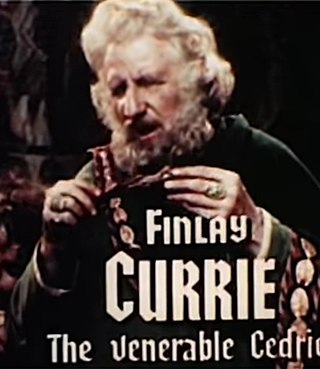
William Finlay Currie was a Scottish actor of stage, screen, and television. He received great acclaim for his roles as Abel Magwitch in the British film Great Expectations (1946) and as Balthazar in the American film Ben-Hur (1959).
Edgar Wallace (1875–1932) was a British novelist, playwright and screenwriter whose works have been adapted for the screen on many occasions. His films fall into two categories, British adaptations and the German "Krimi" films.

Roy James "Philip" Locke was an English actor who had roles in film and television. He is perhaps best known for his part in the James Bond film Thunderball as Largo's personal assistant and chief henchman, Vargas.

Anglo-Amalgamated Productions was a British film production company, run by Nat Cohen and Stuart Levy, which operated from 1945 until roughly 1971. Low-budget and second features, often produced at Merton Park Studios, formed much of its output. It was the UK distributor of many films produced by American International Pictures (AIP), who distributed AA's films in the United States.

John Derek Carson-Parker, known as John Carson, was an English actor known for his appearances in film and television.
James Philip O'Connolly, known professionally as Jim O'Connolly, was an English film director, producer, and screenwriter. He is best known for his work as associate producer of many of the Edgar Wallace Mysteries B-movies made at Merton Park Studios in the early 1960s, as well directing films such as The Hi-Jackers (1963), Smokescreen (1964), Berserk! (1967), and Tower of Evil (1972). He also directed several episodes of ITV's The Saint between 1967–1969.
Merton Park Studios, opened in 1929, was a British film production studio located at Long Lodge, 269 Kingston Road in Merton Park, South London. In the 1940s, it was owned by Piprodia Entertainment, Nikhanj Films and Film Producers Guild.

We Shall See is a 1964 British drama film directed by Quentin Lawrence and starring Maurice Kaufmann, Faith Brook and Alec Mango. It was adapted by Donal Giltinan from the 1926 novel We Shall See! by Edgar Wallace, and was made at Merton Park Studios as part of the long-running series of Edgar Wallace Mysteries.

The Clue of the New Pin is a 1961 British second feature ('B') crime film directed by Allan Davis and starring Paul Daneman, Bernard Archard and James Villiers. The screenplay was by Philip Mackie, based on the 1923 Edgar Wallace novel of the same title which was previously filmed in 1929. It is part of the series of Edgar Wallace Mysteries films made at Merton Park Studios from 1960 to 1965.
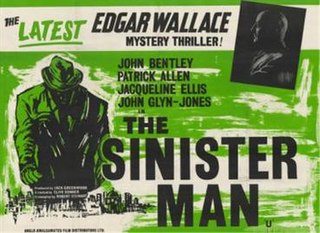
The Sinister Man is a 1961 British crime drama film directed by Clive Donner and starring Patrick Allen and John Bentley. It was one of the series of Edgar Wallace Mysteries, British second-features, produced at Merton Park Studios in the 1960s.
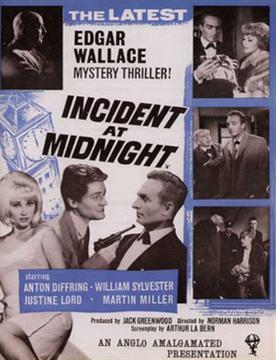
Incident at Midnight is a 1963 British crime film directed by Norman Harrison and starring Anton Diffring, William Sylvester and Justine Lord. It was written by Arthur La Bern, adapted from an Edgar Wallace short story, and was made at Merton Park Studios as part of the series of Edgar Wallace Mysteries.
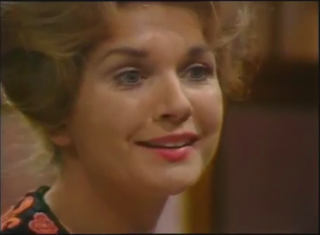
Angela Browne was a British actress. She had a recurring role in the early 1960s crime series Ghost Squad. She also appeared in episodes of shows such as Danger Man, No Hiding Place, The Saint, The Avengers, The Prisoner, Upstairs, Downstairs and Minder. In 1966 she appeared in the Norman Wisdom comedy film Press for Time.

The Malpas Mystery is a 1960 British second feature ('B') crime film, directed by Sidney Hayers and starring Maureen Swanson and Allan Cuthbertson. The screenplay was by Paul Tabori and Gordon Wellesley, based on the 1924 Edgar Wallace novel The Face in the Night.

Clue of the Twisted Candle is a 1960 British second feature crime film directed by Allan Davis and starring Bernard Lee, David Knight and Francis de Wolff. The screenplay was by Philip Mackie, based on the 1918 Edgar Wallace novel The Clue of the Twisted Candle. It is part of the series of Edgar Wallace Mysteries films made at Merton Park Studios from 1960 to 1965.
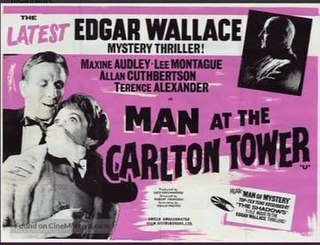
Man at the Carlton Tower is a 1961 British second feature ('B') crime film directed by Robert Tronson and starring Maxine Audley, Lee Montague and Allan Cuthbertson. The screenplay was by Philip Mackie, based on the 1931 Edgar Wallace novel The Man at the Carlton. It is part of the series of Edgar Wallace Mysteries films made at Merton Park Studios from 1960 to 1965.

Marriage of Convenience is a 1960 British crime film directed by Clive Donner and starring Harry H. Corbett, John Cairney and John Van Eyssen. The screenplay was by Robert Banks Stewart, based on the 1924 Edgar Wallace novel The Three Oak Mystery. It is part of the series of Edgar Wallace Mysteries films made at Merton Park Studios from 1960 to 1965.

Clue of the Silver Key is a 1961 British second feature ('B') crime film directed by Gerard Glaister and starring Bernard Lee, Lyndon Brook and Finlay Currie. The screenplay was by Philip Mackie based on the 1930 Edgar Wallace novel of the same title. It is part of the series of Edgar Wallace Mysteries films made at Merton Park Studios from 1960 to 1965.

















